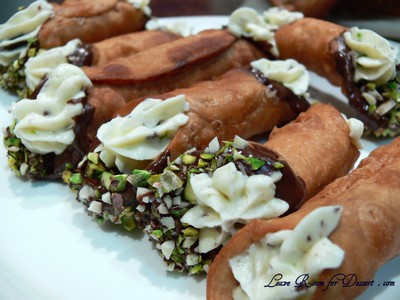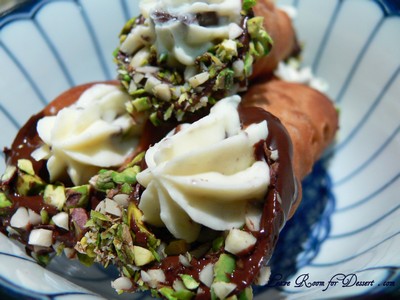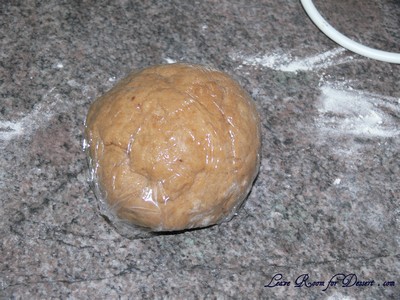
The November 2009 Daring Bakers Challenge was chosen and hosted by Lisa Michele of Parsley, Sage, Desserts and Line Drives. She chose the Italian Pastry, Cannolo (Cannoli is plural), using the cookbooks Lidia’s Italian-American Kitchen by Lidia Matticchio Bastianich and The Sopranos Family Cookbook by Allen Rucker; recipes by Michelle Scicolone, as ingredient/direction guides. She added her own modifications/changes, so the recipe is not 100% verbatim from either book.

Yippee. I had plans to make some cannoli so long ago when I hosted my first cooking class with my family. Unfortunately I didn’t have any metal cannoli tubes/forms, plus – it was probably a bit difficult to make cannoli from scratch plus dinner on a work night.

All I know is I was excited to finally be making cannoli from scratch, even though I had never eaten a bought cannoli before.
I found the dough a bit difficult to roll out, as it kept springing back. Even when it had been rolled out thinly, cut in a circle, rolled into an oval and wrapped around the cannoli tube, it still continued to shrink and resulted in a few quite small/thickish cannoli tubes. This didn’t change how they fried up, they were still great.
I also found they cooked very quickly – 30sec or less at 170-180C and they were perfectly cooked.

Overall, I was quite happy with the cannoli tubes. They went extremely well with the sweet ricotta, pistachio and chocolate filling and lasted very well (not filled) in a sealed container for a few days.
I don’t think it was quite up to the standard of the bought cannoli I tried a day after making these (for a friend’s birthday morning tea). But they were still fantastic. Would I make them again? I might look for a recipe that isn’t as hard to roll out or perhaps use the pasta machine to make it quite thin. I’d also only do it when I’m not in a rush (which I was this time when I was frying the shells, and it seemed to take ages).

Lidisano’s Cannoli
Makes 22-24 4-inch cannoli
Prep time:
Dough – 2 hours and 10-20 minutes, including resting time, and depending on whether you do it by hand or machine.
Filling – 5-10 minutes plus chilling time (about 2 hours or more)
Frying – 1-2 minutes per cannoli
Assemble – 20–30 minutes
CANNOLI SHELLS
2 cups (250 grams/16 ounces) all-purpose flour
2 tablespoons(28 grams/1 ounce) sugar
1 teaspoon (5 grams/0.06 ounces) unsweetened baking cocoa powder
1/2 teaspoon (1.15 grams/0.04 ounces) ground cinnamon
1/2 teaspoon (approx. 3 grams/0.11 ounces) salt
3 tablespoons (42 grams/1.5 ounces) vegetable or olive oil
1 teaspoon (5 grams/0.18 ounces) white wine vinegar
Approximately 1/2 cup (approx. 59 grams/approx. 4 fluid ounces/approx. 125 ml) sweet Marsala or any white or red wine you have on hand
1 large egg, separated (you will need the egg white but not the yolk)
Vegetable or any neutral oil for frying – about 2 quarts (8 cups/approx. 2 litres)
1/2 cup (approx. 62 grams/2 ounces) toasted, chopped pistachio nuts, mini chocolate chips/grated chocolate and/or candied or plain zests, fruits etc.. for garnish
Confectioners’ sugar
Note – If you want a chocolate cannoli dough, substitute a few tablespoons of the flour (about 25%) with a few tablespoons of dark, unsweetened cocoa powder (Dutch process) and a little more wine until you have a workable dough (Thanks to Audax).
CANNOLI FILLING
2 lbs (approx. 3.5 cups/approx. 1 kg/32 ounces) ricotta cheese, drained
1 2/3 cups cup (160 grams/6 ounces) confectioner’s sugar, (more or less, depending on how sweet you want it), sifted
1/2 teaspoon (1.15 grams/0.04 ounces) ground cinnamon
1 teaspoon (4 grams/0.15 ounces) pure vanilla extract or the beans from one vanilla bean
3 tablespoons (approx. 28 grams/approx. 1 ounce) finely chopped good quality chocolate of your choice
2 tablespoons (12 grams/0.42 ounces) of finely chopped, candied orange peel, or the grated zest of one small to medium orange (I added 2 tablespoons chopped slivered almonds)
3 tablespoons (23 grams/0.81 ounce) toasted, finely chopped pistachios
Note – If you want chocolate ricotta filling, add a few tablespoons of dark, unsweetened cocoa powder to the above recipe, and thin it out with a few drops of warm water if too thick to pipe.
DIRECTIONS FOR SHELLS:
In the bowl of an electric stand mixer or food processor, combine the flour, sugar, cocoa, cinnamon, and salt. Stir in the oil, vinegar, and enough of the wine to make a soft dough. Turn the dough out onto a lightly floured surface and knead until smooth and well blended, about 2 minutes. Shape the dough into a ball. Cover with plastic wrap and let rest in the fridge from 2 hours to overnight.

Cut the dough into two pieces. Keep the remaining dough covered while you work. Lightly flour a large cutting or pastry board and roll the dough until super thin, about 1/16 to 1/8” thick (An area of about 13 inches by 18 inches should give you that). Cut out 3 to 5-inch circles (3-inch – small/medium; 4-inch – medium/large; 5-inch;- large. Your choice). Roll the cut out circle into an oval, rolling it larger and thinner if it’s shrunk a little.


Oil the outside of the cannoli tubes (You only have to do this once, as the oil from the deep fry will keep them well, uhh, oiled..lol). Roll a dough oval from the long side (If square, position like a diamond, and place tube/form on the corner closest to you, then roll) around each tube/form and dab a little egg white on the dough where the edges overlap. (Avoid getting egg white on the tube, or the pastry will stick to it.) Press well to seal. Set aside to let the egg white seal dry a little.

In a deep heavy saucepan, pour enough oil to reach a depth of 3 inches, or if using an electric deep-fryer, follow the manufacturer’s directions. Heat the oil to 375°F (190 °C) on a deep fry thermometer, or until a small piece of the dough or bread cube placed in the oil sizzles and browns in 1 minute. Have ready a tray or sheet pan lined with paper towels or paper bags.
Carefully lower a few of the cannoli tubes into the hot oil. Do not crowd the pan. Fry the shells until golden, about 2 minutes (mine took less than 30sec @ 170-180 °C), turning them so that they brown evenly.
Lift a cannoli tube with a wire skimmer or large slotted spoon, out of the oil. Using tongs, grasp the cannoli tube at one end. Very carefully remove the cannoli tube with the open sides straight up and down so that the oil flows back into the pan. Place the tube on paper towels or bags to drain. Repeat with the remaining tubes. While they are still hot, grasp the tubes with a potholder and pull the cannoli shells off the tubes with a pair of tongs, or with your hand protected by an oven mitt or towel. Let the shells cool completely on the paper towels. Place shells on cooling rack until ready to fill.

Repeat making and frying the shells with the remaining dough. If you are reusing the cannoli tubes, let them cool before wrapping them in the dough.
Pasta Machine method:
Divide the dough into 4 equal pieces. Starting at the middle setting, run one of the pieces of dough through the rollers of a pasta machine. Lightly dust the dough with flour as needed to keep it from sticking. Pass the dough through the machine repeatedly, until you reach the highest or second highest setting. The dough should be about 4 inches wide and thin enough to see your hand through
Continue rolling out the remaining dough. If you do not have enough cannoli tubes for all of the dough, lay the pieces of dough on sheets of plastic wrap and keep them covered until you are ready to use them.
Roll, cut out and fry the cannoli shells as according to the directions above.
DIRECTIONS FOR FILLING:
Line a strainer with cheesecloth. Place the ricotta in the strainer over a bowl, and cover with plastic wrap and a towel. Weight it down with a heavy can, and let the ricotta drain in the refrigerator for several hours to overnight.
In a bowl with electric mixer, beat ricotta until smooth and creamy. Beat in confectioner’s sugar, cinnamon, vanilla and blend until smooth. Transfer to another bowl and stir in chocolate, zest and nuts. Chill until firm.(The filling can be made up to 24 hours prior to filling the shells. Just cover and keep refrigerated).
ASSEMBLE THE CANNOLI:
When ready to serve..fill a pastry bag fitted with a 1/2-inch plain or star tip, or a ziplock bag, with the ricotta cream. If using a ziplock bag, cut about 1/2 inch off one corner. Insert the tip in the cannoli shell and squeeze gently until the shell is half filled. Turn the shell and fill the other side. You can also use a teaspoon to do this, although it’s messier and will take longer.
Press or dip cannoli in chopped pistachios, grated chocolate/mini chocolate chips, candied fruit or zest into the cream at each end. Dust with confectioner’s sugar and/or drizzles of melted chocolate if desired.

TIPS AND NOTES:
– Dough must be stiff and well kneaded
– Rolling the dough to paper thinness, using either a rolling pin or pasta machine, is very important. If the dough is not rolled thin enough, it will not blister, and good cannoli should have a blistered surface.
– Initially, this dough is VERY stubborn, but keep rolling, it eventually gives in. Before cutting the shapes, let the dough rest a bit, covered, as it tends to spring back into a smaller shapes once cut. Then again, you can also roll circles larger after they’re cut, and/or into ovals, which gives you more space for filling.
– Your basic set of round cutters usually doesn’t contain a 5-inch cutter. Try a plastic container top, bowl etc, or just roll each circle to 5 inches. There will always be something in your kitchen that’s round and 5-inches if you want large cannoli.
– Oil should be at least 3 inches deep and hot – 360°F-375°F, or you’ll end up with greasy shells. I prefer 350°F – 360°F because I felt the shells darkened too quickly at 375°F.
– If using the cannoli forms, when you drop the dough on the form into the oil, they tend to sink to the bottom, resulting in one side darkening more. Use a slotted spoon or skimmer to gently lift and roll them while frying.
– DO NOT crowd the pan. Cannoli should be fried 2-4 at a time, depending on the width of your saucepan or deep fryer. Turn them once, and lift them out gently with a slotted spoon/wire skimmer and tongs. Just use a wire strainer or slotted spoon for flat cannoli shapes.
– When the cannoli turns light brown – uniform in color, watch it closely or remove it. If it’s already a deep brown when you remove it, you might end up with a really dark or slightly burnt shell.
– Depending on how much scrap you have left after cutting out all of your cannoli shapes, you can either fry them up and sprinkle with confectioner’s sugar for a crispy treat, or let the scraps rest under plastic wrap and a towel, then re-roll and cut more cannoli shapes.
– Push forms out of cannoli very gently, being careful not to break the shells as they are very delicate. DO NOT let the cannoli cool on the form, or you may never get it off without it breaking. Try to take it off while still hot. Hold it with a cloth in the center, and push the form out with a butter knife or the back of a spoon.
– When adding the confectioner’s sugar to the filling..TASTE. You may like it sweeter than what the recipe calls for, or less sweet, so add in increments.
– Fill cannoli right before serving! If you fill them an hour or so prior, you’ll end up with soggy cannoli shells.
– If you want to prepare the shells ahead of time, store them in an airtight container, then re-crisp in a 350°F (176 °C) oven for a few minutes, before filling.
– Practice makes perfect. My first batch of shells came out less than spectacular, and that’s an understatement. As you go along, you’ll see what will make them more aesthetically pleasing, and adjust accordingly when rolling. My next several batches turned out great. Don’t give up!!


Well done on the challenge Anita! Your cannolis remind me of the ones I saw in Italy!
Love all your step-by-step photos which really help to understand the process. Strangely I had no problems with the dough in fact it was very soft and rolled out very easily! Your cannoli shells look so warty (blistered) well done and glad to hear you finally made from stratch so well. Cheers from Audax in Sydney. Lovely and very clear photos and the filling sounds so delicious. Aud
These look great – they turned out perfectly. Like the cream horn ones too – I saw cream horns in Melbourne recent;y and passed on them – now I want them!!!
they look absolutely amazing. love the color of this shells.
Your cannoli look lovely! I wish I could have gotten mine to blister as much as yours, mine barely did and only when I rolled it super super thin. Awesome effort!
Wow these look beautiful. And I agree, that dough was tough to work with! I think if I was to try it again, I’m gonna rope in the man to help with the rolling!
GREAT looking cannolis!!
They look very pretty! I like the pistachios with the chocolate.
These look delicious! Such gorgeous photos =D.
Great job on those chocolate cannolis. YUM!
Think your cannoli look lovely. Yes, ricotta and pistachios are a good combination. I also used cardamom in mine.
I had the same problem with the dough shrinking. Your cannoli are picture perfect!
Lovely chocolate dipped cannoli. My pastry would shrink back a little, but I just kept persisting! 🙂
Nice job, they look beautiful!
they look picture perfect Anita! Are you sure you weren’t a cannoli chef in a past life? 🙂
Your cannoli are very pretty! They are so tempting and scrumptious looking!
Cheers,
Rosa
Your cannoli look great! I noticed a few people used a pasta machine to roll out the dough – with great results. A good tip for future reference, I reckon.
Picture perfect, like right out of an Italian bakery.
Mimi
Your cannoli turned out beautiful, and your shells are blistery perfection! Yes, the dough is a pain, and it took me two weeks to finally achieve what I was looking for. I found that rolll..cover..rest..roll..cover..rest, eventually ‘broke’ the dough and it succumbed to my every whim. That’s how you finally break through…you see how far it can push you, and keep pushing back 🙂 Thank you so much for deep frying with me this month!
I love the chocolate and pistachios on the shells. I wish I had done that. Even though they were rushed, they still look delicious!
Was this even a CHALLENGE to you?! you make it seem SO darn easy! They look terrific! Absolutely perfect!
Oh my god, truly great presentation..looks like lot of work, good entry for the challenge. Quite interesting and new recipe…thans for sharing it with us.
these look lovely, anita! they’re perfect, all the way down to the splattering of pistachios. bravo. 🙂
wow, your so brave to attempt this recipe even before you’ve tried a cannolo. I’ve made cannoli shells before and thought….bugger that to much effort for result. So I just buy the shells pre-made now and fill them with whatever tickles my fancy. I must admit thought, ricotta is one of the best fillings of all time!!
Nice work with the cannoli and the post.
I’ve noticed a number of people have stated that they’d never tried store bought cannoli before this challenge, which I found rather interesting.
You did a fabulous job on your cannoli! Great picture too.
Natalie @ Gluten A Go Go